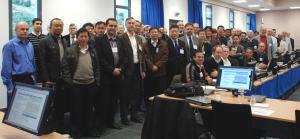The unique art of tokamak grounding
3 Dec 2010
It was an impressive group of experts in their field that had come together for a two-day workshop to discuss the earthing policy of ITER.
While the first buildings of the ITER facility are rapidly taking shape on the platform, only a few hundred meters away at the Château de Cadarache a group of very skilled and specialized engineers this week took a close look at the earthing and electromagnetic compatibility (EMC) design for ITER. Because what sounds trivial in a private household is far from trivial for what will become the world's biggest tokamak ever built.
It was an impressive group of experts in their field that had come together for a two-day workshop to discuss the earthing policy of ITER. Amongst the experts were engineers from: CERN; the Experimental Advanced Superconducting Tokamak (EAST) in Hefei, China; the National Ignition Facility (NIF) in Livermore, California (US); NSTK in Princeton, New Jersey (US); Aditya in Gujarat, India; Asdex Upgrade in Garching, Germany; JT-60 in Naka, Japan; KSTAR in Daejon, South Korea; and the Laser Megajoule Project in Bordeaux, France. And the question was, would the "business as usual" option hold for a project with the dimension of ITER?
With operating voltages up to 1 MV and currents up to 68 kA, "earthing becomes a very important issue," said Kofi Korsak, a nuclear engineer from Oak Ridge National Laboratory. "One thing that we are looking at is the shielding of the equipment against the high magnetic fields—especially the instrumentation and control systems need to be protected. There are a lot of unknowns in a fusion environment compared to the experience we have gained in building fission plants," Kofi Korsak said.
"This workshop is very important as it focuses on tokamak grounding which is a unique art," Charles Neumeyer from the Princeton Plasma Physics Lab added. "There exist lots of types of grounding techniques in the world, but a tokamak has unique characteristics such as a big stray magnetic field, plasma disruptions, fast discharges. All of those features have to be incorporated into the design of the ITER grounding which makes it so completely different than building AC power systems or accelerators."
Another feature that makes ITER unique compared to existing tokamaks such as JET or TFTR is the extended length of its plasma pulses, explains the "Engineer of the Year 2001." The biggest challenge Neumeyer and his fellow colleagues see are the large stray magnetic fields and the magnetic moment that will be much larger than in any tokamak ever built. Even outside the Tokamak hall, in the adjacent building, this stray magnetic field could have an effect on the instruments if no countermeasures are taken. Another challenge is how to shield cables and instrumentation against all the interferences generated by the heating systems, which could inject many kilo-Ampère (kA) in the earth and radiated MW at high frequency.
So what is the solution for ITER? "Many of the tokamak people are stuck with the prior practice," Charles Neumeyer says. "They have almost a religious feeling of how this was done in the past with isolating breaks. And there are some folks who are advocating a new approach which is to avoid isolating breaks and to connect the whole thing. Those two roots have not yet converged. So we are here to seek for a clear explanation, for a clear engineering justification to do it the one way or the other, to follow the traditional approach or to go for a new one."
ITER is the first large tokamak facility—around 10 times larger than the current ones. During the workshop, there were reports about large facilities where major (and expensive) upgrades were done due to earthing and EMC problems, just to apply the same principles than in previous small experiments.
For Charles Neumeyer and his fellow engineers this is new territory, "a fascinating experience." You go through a phase of confusion, uncertainty and frustration—and then you solve the problem. I have no doubt about that."


